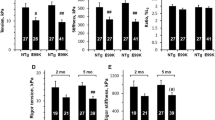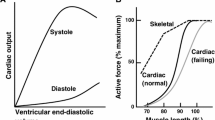Abstract
The role of cardiac myosin binding protein-C (MyBP-C) on myocardial stiffness was examined in skinned papillary muscles of wild-type (WT+/+) and homozygous truncated cardiac MyBP-C (MyBP-Ct/t) male mice. No MyBP-C was detected by gel electrophoresis or by Western blots in the MyBP-Ct/t myocardium. Rigor-bridge dependent myofilament stiffness, i.e., rigor minus relaxed stiffness, in the MyBP-Ct/t myocardium (281 ± 44 kN/m2) was 44% that in WT+/+ (633 ± 141 kN/m2). The center-to-center spacing between thick filaments as determined by X-ray diffraction in MyBP-Ct/t (45.0 ± 1.2 nm) was not significantly different from that in WT+/+ (43.2 ± 0.9 nm). The fraction of cross-sectional area comprised of myofibrils, as determined by electron microscopy, was reduced in the MyBP-Ct/t (39.9%) by 10% compared to WT+/+ (44.5%). These data suggest that the 56% reduction in rigor-bridge dependent stiffness of the skinned MyBP-Ct/t myocardium could not be due solely to a 10% reduction in the number of thick filaments per cross-sectional area and must also be due to approximately 50% reduction in the stiffness of the rigor-bridge attached thick filaments lacking MyBP-C. (Mol Cell Biochem 263: 73–80, 2004)
Similar content being viewed by others
References
Starr R, Offer G: Polypeptide chains of intermediate molecular weight in myosin preparations. FEBS Lett 15: 40–44, 1971
Craig R, Offer G: The location of C-protein in rabbit skeletal muscle. J Mol Biol 102: 325–332, 1976
Bennett P, Craig R, Starr R, Offer G: The ultrastructure location of C-protein, X-protein and H-protein in rabbit muscle. J Muscle Res Cell Motil 7: 550–567, 1986
Starr R, Offer G: The interactions of C-protein with heavy meromyosin and subfragment-2. Biochem J 171: 813–816, 1978
Moos C, Feng IM: Effect of C-protein on actomyosin ATPase. Biochim Biophys Acta 632: 141–149, 1980
Koretz JF, Coluccio LM, Bertasso AM: The aggregation characteristics of column-purified rabbit skeletal myosin in the presence and absence of C-protein at pH 7.0. Biophys J 37: 433–440, 1982
Gilbert R, Kelly MG, Mikawa T, Fischman DA: The carboxyl terminus of myosin binding protein C (MyBP-C, C-protein) specifies incorpora-tion into the A-band of striated muscle. J Cell Sci 109: 101–111, 1996
Hofmann PA, Hartzell HC, Moss RL: Alterations in Ca2+ sensitive tension due to partial extraction of C-protein from rat skinned cardiac myocytes and rabbit skeletal muscle fibers. J Gen Physiol 97: 1141–1163, 1991
Harris SP, Bartley CR, Hacker TA, McDonald KS, Douglas PS, Greaser ML, Powers PA, Moss RL: Hypertrophic cardiomyopathy in cardiac myosin binding protein-C knockout mice. Circ Res 90: 592–601, 2002
Gautel M, Zuffardi O, Freiburg A, Labeit S: Phosphorylation switches specific for the cardiac isoforms of myosin binding protein C: A mod-ulator of cardiac contraction. EMBO J 14: 1952–1956, 1995
Hofmann PA, Lange JH: Effects of phosphorylation of troponin I and C protein on isometric tension and velocity of unloaded shortening in skinned single cardiac myocytes from rats. Circ Res 74: 718–726, 1994
Winegrad S: Cardiac myosin binding protein C. Circ Res 84: 1117–1126, 1999
Yang Q, Sanbe A, Osinska H, Hewitt TE, Klevitsky R, Robbins J: A mouse model of myosin binding protein C human familial hypertrophic cardiomyopathy. J Clin Invest 102: 1292–1300, 1998
McConnell BK, Jones KA, Fatkin D, Arroyo LH, Lee RT, Aristizabal O, Turnbull DH, Georgakopoulos D, Kass D, Bond M, Niimura H, Schoen FJ, Connor D, Fischman DH, Seidman CE, Seidman JG: Di-lated cardiomyopathy in homozygous myosin-binding protein-C mutant mice. J Clin Invest 104: 1235–1244, 1999
Godt RE, Lindley BD: Influence of temperature upon contractile acti-vation and isometric force production in mechanically skinned muscle fibers of the frog. J Gen Physiol 80: 279–297, 1982
Mulieri LA, Hasenfuss G, Ittleman F, Blanchard EM, Alpert NR: Protection of human left ventricular myocardium from cutting injury with 2,3 butanedione monoxine. Circ Res 65: 1441–1444, 1989
Blanchard E, Seidman C, Seidman JG, LeWinter M, Maughan D: Al-tered crossbridge kinetics in the á MHC403/+ mouse model of familial hypertrophic cardiomyopathy. Circ Res 84: 475–483, 1999
Irving TC, Konhilas J, Perry D, Fischetti R, and De Tombe PP: My-ofilament lattice spacing as a function of sarcomere length in isolated rat myocardium. Am J Physiol Heart Circ Physiol 279: H2568–H2573,2000
Kunst G, Kress KR, Gruen M, Uttenweiler D, Gautel M, Fink RHA: Myosin binding protein C, a phosphorylation-dependent force regulator in muscle that controls the attachment of myosin heads by its interaction with myosin S2. Circ Res 86: 51–58, 2000
Witt CC, Gerull B, Davies MJ, Centner T, Linke WA, Thierfelder L: Hypercontractile properties of cardiac muscle fibers in a knock-in mouse model of cardiac myosin-binding protein-C. J Biol Chem 276: 5353–5359, 2001
Palmiter KA, Tyska MJ, Dupuis DE, Alpert NR, Warshaw DM: Kinetic differences at the single molecule level account for the functional diver-sity of rabbit cardiac myosin isoforms. J Physiol (Lond) 519: 669–678,1999
Irving TC, Millman BM: The Z-line/I-band and A-band lattices of intact vertebrate striated muscle at altered interfilament spacing. J Musc Res Cell Motil 13: 100–105, 1992
Rottbauer W, Gautel M, Zehelein J, Labeit S, Franz WM, Fischer C, Vollrath B, Mall G, Dietz R, Kübler W, Katus HA: Novel splice donor site mutation in the cardiac myosin-binding protein-C gene in familial hypertrophic cardiomyopathy. J Clin Invest 100: 475–482, 1997
Moolman JA, Reith S, Uhl K, Bailey S, Gautel M, Jeschke B, Fischer C, Ochs J, McKenna WJ, Klues H, Vosberg H-R: A newly created splice donor site in exon 25 of the MyBP-C gene is responsible for inher-ited hypertrophic cardiomyopathy with incomplete disease penetrance. Circulation 101: 1396–1402, 2000
Capasso JM, Palackal T, Olivetti G, Anversa P: Left ventricular failure induced by long term hypertension in rats. Circ Res 66: 1400–1412 1990
Author information
Authors and Affiliations
Rights and permissions
About this article
Cite this article
Palmer, B.M., McConnell, B.K., Li, G.H. et al. Reduced cross-bridge dependent stiffness of skinned myocardium from mice lacking cardiac myosin binding protein-C. Mol Cell Biochem 263, 73–80 (2004). https://doi.org/10.1023/B:MCBI.0000041849.60591.45
Issue Date:
DOI: https://doi.org/10.1023/B:MCBI.0000041849.60591.45




